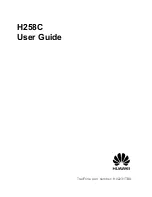
The antenna, including the 300
Ω
feedline, should also be mounted as far from other structures
as possible. This includes the ends of the wire elements, which are actually the most sensitive
part of the antenna. Any objects, metal in particular, within the near-field radiation pattern can
affect the impedance and radiation pattern of the antenna. The feedline should also come away
from the antenna at right angles for at least 1/2-wavelength for best performance.
Most installations involve compromises due to local terrain, available supporting structures, or
other restrictions. Do the best you can with what you have.
Installation
You should have two rolls of element wire, one 100 foot roll of ladder feedline, and a hardware
packet. Unroll the 2 wire elements and feedline using a hand-over-hand technique. This will
prevent kinks and allow the wires to lay flat.
Feedline
The DX Engineering Linear-Loaded Multi-Band Dipoles include 100 feet of high quality 300
Ω
ladder line. Depending on your specific installation, this feedline will need to be shortened or
lengthened.
The feedline must be in
odd
multiple lengths of 1/8-wavelength on the lowest operating
frequency, in this case 3.5 MHz, to optimize the impedance presented to the balun over the
frequency range of the antenna. This length can be calculated using the following formula or use
Table 1
. The DX Engineering 300
Ω
ladder feedline has a VF of 0.88.
Formula:
123 / Freq (MHz) x VF: Multiply the result times the ODD multiple (1, 3, 5, 7, etc) to get
the correct length closest to your required feedline length.
Where:
123 = 1/8-Wavelength Factor
Freq = Frequency in MHz
- 4 -
VF = Velocity Factor of Feedline






























